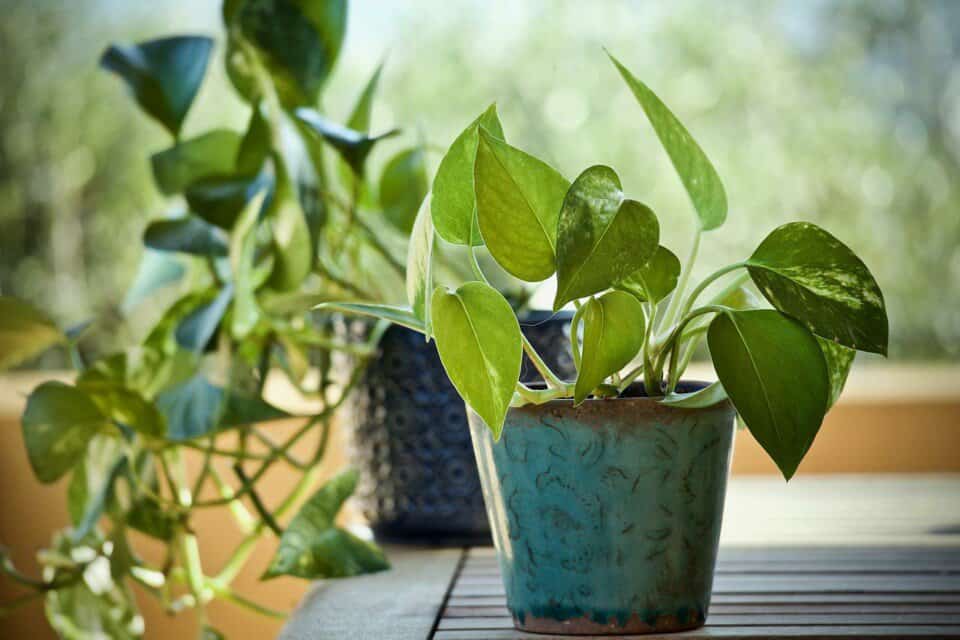Some links in the post are affiliate links and I get a commission from purchases made through some links found in the post.
Pothos is a decorative houseplant that is native to tropical regions. This beautiful plant tends to grow very quickly and is easy to maintain.
If the plant is well cared for, it can grow as long as 30 feet. You can either have them climb on the pole or planted in hanging baskets. Anyways, they are beautiful and will make a perfect green addition to any place.
Since the pothos plant is very fast-growing, it is recommended to repot them every year. Repotting a pothos gives the plant roots the possibility to grow freely and also helps to avoid health problems.
In this article, we will talk about how to repot the pothos plant in more detail. Additionally, some care tips will be discussed which will guide you and help you in every step of the pothos repotting process. So, let’s start digging.
Do Pothos Plants like to be Root Bound?
 Pothos plants can be slightly root-bound and will not be greatly affected by it, however, generally, Pothos plants dislike being root-bound because it prevents them from receiving water and nutrients and slows their development.
Pothos plants can be slightly root-bound and will not be greatly affected by it, however, generally, Pothos plants dislike being root-bound because it prevents them from receiving water and nutrients and slows their development.
Root-bound plants have roots that wind around the pot’s base and might begin to protrude through the drainage holes.
Pothos plants that are root-bound should be transplanted in a new container with brand-new potting soil.
Typically, the roots of the root bounded pothos will swirl around in the pot and when out of space, either go out from the drainage holes or start sticking up from the soil.
This may occur if the plant is growing in an inadequately sized container, if it has been there for an excessively long time, or if it has grown quickly.
As their roots occupy the available area, pothos that are root-bound may struggle to absorb the nutrients and water they require and may even suffer from a lack of air.
This may result in sluggish leaf development, brown or yellow leaves, and even plant death.
How do you Know When to Repot a Pothos?
There are some signs that can tell you when the plant needs to be Repotted. Your plant is prepared for pothos repotting when:
- The foliage sags and leaves start to droop.
- Roots start to be visible from the drainage holes of the pot.
- The roots are emerging from the surface of the soil.
If any of these occur, you should carefully remove your plant from the container the following time the soil is dry to see if it has been rootbound.
You may need to investigate other issues if the roots haven’t outgrown the container because leaf drooping can also be caused by a number of other issues.
Pothos repotting is best done in the spring or summer when the plant is actively developing. This is the growth period for the greenery and the plant starts to absorb a high amount of nutrients.
Therefore, when replanted in the spring, it will be at its healthiest and most equipped to recover from the stress of being disturbed and relocated to a new location.
How to Repot a Pothos?
When planning to repot the pothos, you should water your plant at least two days in advance to ensure that its roots are adequately moist.
Making sure the roots are well-hydrated reduces the possibility of root shock, but providing the soil a two-day period to dry out makes it simpler to remove the plant from the container.
Additionally, it guarantees that the roots suffer the least amount of harm possible when taken out from dry soil.
Pothos repotting is done somewhat similarly to any other plant. You merely need to be careful with the vines while repotting a pothos.
To do the least amount of harm, be sure to hold the plant’s base near the roots rather than the ends of the vines as you go through the procedure.
Before you remove the pothos from the old pot, you should have your new pot ready. The new one has to be a few inches larger if you want to allow it to grow bigger.
Size is taken into account initially. Pothos plants are frequently repotted into planters that are a few inches wider than their previous containers.
Most plant parents steer clear of placing really tiny plants in extraordinarily large pots since the potting soil might remain moist for a very long period and the plant would likely appear weird with so much dirt surrounding it.
The next thing that needs to be also considered is drainage holes. In general, you should transplant the Pothos into a drainage that has holes in the bottom.
Many pots do not come with drainage holes, this is to protect the surface on which the pot sits. Therefore, watch out for them, because they can make it impossible to get rid of excess water.
Repotting a pothos is not difficult and can be done in several simple steps:
- Take the pothos from their current container slowly. Seen the root ball? The root ball may be readily transplanted into a new pot if there aren’t too many roots visible circling around it. However, if the plant has several roots around the outside of the rootball, it may be helpful to untangle them to avoid a root-bound plant.
- Soak the Pothos plant’s root ball in water to aid the recovery of twisted, bound roots. You may either carefully split up the potting soil to look at the roots more closely, or you can gently guide the roots out from the ball. To avoid accidentally destroying roots, be extra careful and slow. The Pothos plant may really be made up of multiple different stems that have all been rooted in the same container of potting soil. When repotting a pothos, you can divide the plants and grow them in separate pots.
- Put a few scoops of potting soil in the bottom of the new pot. It is essential because the new planters are generally larger than the previous ones to support the plant growth. Therefore, the pot itself will most likely be taller, therefore, the plant will require some pad of dirt to sit on in order to be elevated to the top. Once you put some dirt in the bottom, you can put the plant in the new pot. It is recommended, to have the soil filled up 1 inch below the top of the planter. This way, when watering, the dirt and water will not come over the pot.
- If the plant was root bounded, then most likely it will require to be separated into different pots. Or, you can get the larger pot and place the pothos plant pieces at a distance from one another, make sure to put the soil between the roots, so they have the possibility to develop on its own and not get bounded.
- Newly repotted pothos plants do require watering. You can put the water on the pot slowly, this will help the soil to compress and get moisture. Typically, after the first watering, the soil goes down a little bit, which is absolutely normal, and you can even it out by adding some more dirt on top.
How to Repot Pothos with a Pole and a Moss Pole
 When pothos repotting is done with a moss pole, it has support that helps in growth, and additionally, much more water and nutrients are accessible to the plant.
When pothos repotting is done with a moss pole, it has support that helps in growth, and additionally, much more water and nutrients are accessible to the plant.
A pothos plant gives you an opportunity to modify it as you wish. they can grow horizontally, downwards, or with the help of a moss pole, upwards.
Pothos can flourish without a moss pole, especially because it resembles their natural environment. In the natural environment, pothos relies on the support of tree trunks to flourish.
They cling by inserting their aerial roots into the structure’s framework. You may create a more natural growing environment for your pothos inside with the aid of a moss pole.
Using the moss pole can be pretty beneficial for your plant and it comes with several benefits:
- It helps to maintain and support the plant.
- Gives pothos the growth direction.
- Triggers the growth of foliage, stems, and aerial roots.
- Give the plant needed vitamins and minerals.
- Helps the leaves to grow bigger and healthier.
The first step of the repotting a pothos with a moss pole is to actually get the moss pole. Those sticks come in different lengths and you can choose the one that suits your needs the most. Some moss poles are extendable too.
The next step is to choose the appropriate pot for the plant and moss pole. The pot has to be so wide to fit both the pothos plant and moss pole without taking large space from roots.
Try to put the pole near the pothos roots, but make sure not to damage it. This way, it will be easier to tie the stems and vines to it.
Hold the pole steady in the middle of the pot and add some soil to make it fixed to one place. Add some more soil, and gently place the plant in it.
You can get pins or wires to attach the veins to the pole. Put the pins 3 to 4 inches apart and slowly put all the veins and leaves up on the pole.
In the few weeks, you will see the pothos plant developing aerial roots and will start to get firmly attached to the moss pole by itself.
Should I Water Pothos after Repotting
A pothos plant needs to be watered after repotting. If your foliage starts to wilt after pothos repotting, then it can be caused by the lack of water.
The soil may be lacking moisture and therefore, roots would not be able to absorb any. Make sure to water a newly repotted pothos plant well, and give them additional water every week.
Do not give your pothos plant tap water. It contains the chemicals such as chlorine that can greatly damage the plant. It is always better to use either distilled water or rainwater.
However, if none of those are available, you can fill the jar with tap water and let it sit out for a 24-hour period. The chloride and harmful chemicals will be evaporated and the tap water will become good to use.
What Kind of Soil does a Pothos Need to Repot in
A pothos plant enjoys the soil that has good drainage and holds the moisture properly. A pothos likes to be repotted in soil with pH levels between 6- 6.5.
The soil that is made from a mixture of peat moss, perlite, and bark fins will provide the perfect nutrients and a drainage environment for your beloved plants.
Your plant may experience a number of issues if you give your pothos plant the incorrect soil mixture.
If done so, the roots won’t be able to get enough oxygen and additionally, will not get proper nutrients for development. On the other hand, dehydrated plants will result from soils that can’t store enough water.
After Repotting Care Tips for your Pothos
- Give your pothos plant the water immediately after you have repot it, this will cause the shock to the roots and will encourage the plant to grow.
- Put the plant in the same spot that it was before repotting the pothos, this way, you will prevent your plant from getting additional stress due to the changes in light and humidity conditions.
- If you see the yellowing and wilting leaves, it may be because of the stress and should go away in a few weeks. Do not panic and do not change the care routine because of it. This will only cause additional problems. If the problem has not been resolved by itself in a month, then it is time to start looking for the cause.
Final Thoughts
 Pothos plant is a very beautiful decorative greenery that tends to grow pretty fast. Therefore, it is essential to repot it approximately every year. Repotting a pothos is not difficult at all and it can be done easily.
Pothos plant is a very beautiful decorative greenery that tends to grow pretty fast. Therefore, it is essential to repot it approximately every year. Repotting a pothos is not difficult at all and it can be done easily.
Make sure to get the appropriate soil that pothos plants enjoy and the pot that is relatively larger in comparison to the previous one.
This way, your beloved greenery will have a possibility to grow and spread roots freely. Make sure to water your pothos after replanting and put them in bright indirect sunlight.


